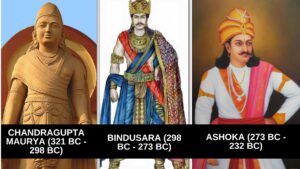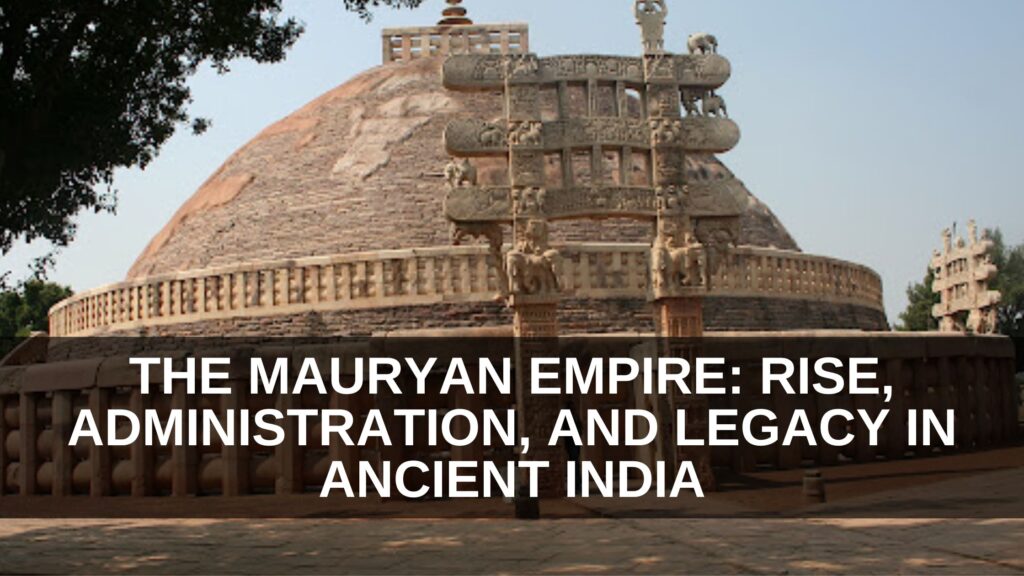The Mauryan Empire was a significant period in Indian history, marking the first time a vast portion of the Indian subcontinent was unified under a single ruler. Emerging after the decline of the Nanda dynasty, the Mauryan Empire flourished under strong and visionary leaders, including Chandragupta Maurya, Bindusara, and Ashoka. This blog explores the empire’s expansion, administration, and governance.
Foundation and Expansion
- Chandragupta Maurya (321 BC – 298 BC)
Chandragupta Maurya, with the strategic guidance of his minister Kautilya (Chanakya), overthrew the last Nanda ruler, Dhanananda, in 321 BC. He expanded his empire westward, defeating Seleucus Nikator, a former general of Alexander the Great. This victory granted Chandragupta territories as far as Afghanistan and Baluchistan. Later in his reign, he embraced Jainism and abdicated his throne, retiring to Sravanabelagola in Karnataka. - Bindusara (298 BC – 273 BC)
Bindusara, also known as Amitraghata (Slayer of Foes), faced internal revolts during his reign. To maintain control, he appointed his son Ashoka as governor of Taxila and later Ujjain. Bindusara expanded the empire further south and was a patron of the Ajivika sect. After his death, a power struggle ensued, from which Ashoka emerged victorious. - Ashoka (273 BC – 232 BC)
Ashoka initially pursued aggressive expansion policies, most notably conquering Kalinga in 260 BC after a brutal war. However, the devastating consequences of the battle led him to renounce violence. Adopting Buddhism, he shifted to a policy of Dhamma (righteousness), spreading his message of peace and morality across the empire and beyond.

Mauryan Administration
Central Administration
The Mauryan administration was hierarchical and well-organized. The king was the supreme authority, supported by ministers and advisors.
- Saptanga Theory: According to Kautilya’s Arthashastra, the state was based on seven elements:
- Swami (King)
- Amatya (Ministers)
- Janapada (Territory and people)
- Durga (Fortified capital)
- Kosha (Treasury)
- Danda (Justice and military)
- Mitra (Allies)
- Mantri Parishad: A council of ministers assisted the king, though the final authority rested with him.
Read about Harappan Civilization
Military Strength
The Mauryan army was one of the largest in the ancient world:
- 600,000 infantry
- 30,000 cavalry
- 9,000 elephants
- 8,000 chariots Military administration was divided into specialized units, with officers such as:
- Patyadhyaksha (Infantry commander)
- Ashvadhyaksha (Cavalry commander)
- Rathadhyaksha (Chariot commander)
- Hastyadhaksha (Elephant commander)
Additionally, Megasthenes, a Greek ambassador, described a military system with six sub-committees for different defense aspects, including the navy and transport.
Espionage System
Kautilya’s Arthashastra details an advanced espionage system, which included:
- Mahamatya-pasarpa (Head of espionage)
- Gudhapurushas (Secret agents)
- Sansthan (Stationary spies)
- Sancharas (Traveling spies) Agents included students, merchants, and even poison-trained women (Vishkanyas).
Legal and Welfare Systems
Law and Justice
Two types of courts existed:
- Civil courts (Dharmasthiyas) handled legal disputes.
- Criminal courts (Kantakasodhanas) dealt with crimes and punishments. The king was the highest judicial authority, ensuring fairness and justice.
Public Welfare Initiatives
The Mauryan state undertook welfare projects such as:
- Road construction
- Irrigation works
- Medical aid
- Relief during famines and natural calamities Ashoka’s edicts emphasize his commitment to social welfare, including hospitals and rest houses.
Provincial and Local Administration
The empire was divided into five provinces, each governed by a royal prince (Kumara):
- Uttarapatha (North) – Taxila
- Avantipatha (West) – Ujjayini
- Dakshinapatha (South) – Suvarnagiri
- Magadha (Centre) – Pataliputra
- Kalinga (East) – Tosali
At the district level, officials such as Pradeshikas (district administrators), Rajukas (magistrates), and Yukatas (secretarial assistants) ensured smooth governance. Villages enjoyed autonomy, with Gramikas serving as local leaders.
City Administration
Cities like Pataliputra had well-defined administration systems:
- Nagarika – Head of city administration
- Bandhanagaradhyaksha – In charge of jails
- Rakshi – Police officer
- Gramika – Village head A City Council oversaw trade, taxation, and public services, with six sub-committees focusing on various aspects such as industry, trade, foreign visitors, and registration of births and deaths.
Read about Mauryan Society
Taxation System
Kautilya’s Arthashastra mentions various taxes, including:
- Bhaga (Land revenue – 1/4 to 1/6 of produce)
- Shulka (Customs duty)
- Pravesya (Import tax)
- Parigha (Monopoly tax) Taxes could be paid in cash, kind, or labor. Forced labor (Vishti) was levied on lower castes and slaves.
The state had a monopoly over key industries such as mining, salt production, and liquor trade. Additionally, military taxation, such as Ayudhiya (villages supplying soldiers), ensured a steady supply of troops.
Decline of the Mauryan Empire
After Ashoka’s death in 232 BC, the empire weakened due to internal divisions and external threats. Successors such as Kunal, Samprati, and Dasaratha ruled over fragmented regions. In 184 BC, the last Mauryan ruler, Brihadratha, was assassinated by Pushyamitra Sunga, marking the end of the Mauryan era.


